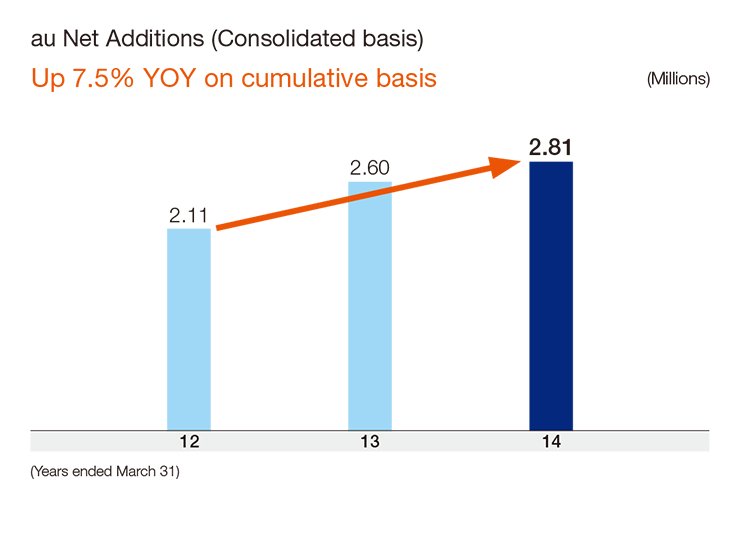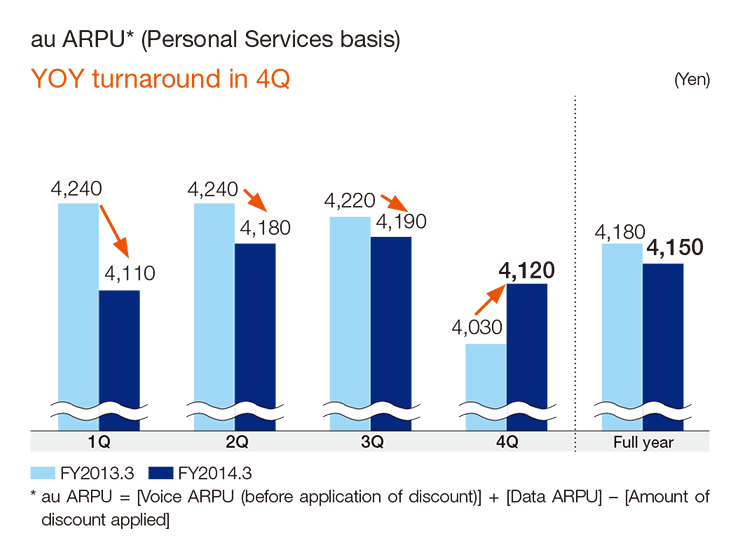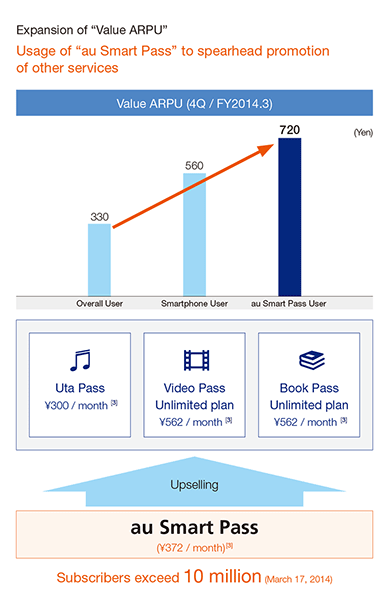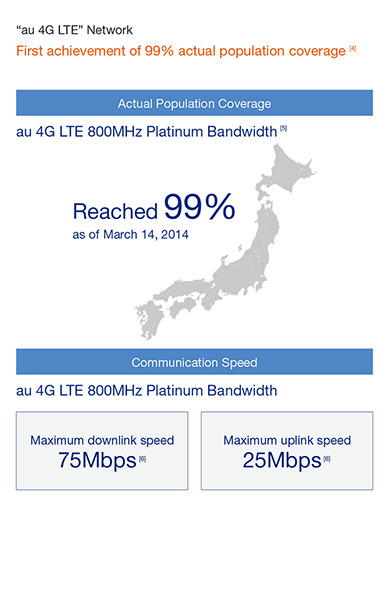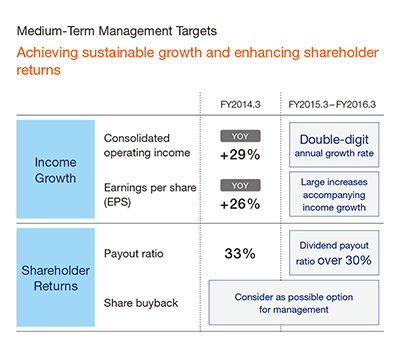- KDDI HOME
 Corporate Information
Corporate Information  Investor Relations
Investor Relations  IR Documents
IR Documents  Integrated Report
Integrated Report  Selected Pages of Integrated Report (2014)
Selected Pages of Integrated Report (2014)  Message from the President
Message from the President
Message from the President

By delivering value that exceeds expectations in a host of fields, we aim to differentiate ourselves from competitors and are targeting the next growth stage.
Takashi Tanaka
President, KDDI CORPORATION
THEME 01
Looking Back on the Three Years Since Being Appointed President, and the First Year of Medium-Term Management Targets Leading to the Fiscal Year Ending March 31, 2016
During the first fiscal year after I was appointed president in December 2010, the fiscal year ended March 31, 2012, I concentrated first on the reconstruction of the mobile business―our foundational business. By doing so, we shored up our corporate footings prior to the full-fledged launch of our medium-term growth strategy, the "3M Strategy."
At that point in time, we were losing subscribers to competitors through mobile number portability (MNP) and were unable to keep pace with other companies in terms of data average revenue per unit (ARPU) growth. Under those circumstances, I sought to share a sense of urgency among all employees, and we worked to achieve a complete recovery of au momentum by improving against four key performance indicators (KPIs): au churn rate, MNP net additions, au net additions, and data ARPU.
My second year at the helm, the fiscal year ended March 31, 2013, marked the full-fledged rollout of our "3M Strategy."
In addition to boosting sales of services aimed at realizing the "3M Strategy"―"au Smart Value" and "au Smart Pass"―we honored the two commitments we had made at the beginning of the fiscal year: reaching ¥500 billion in consolidated operating income and seeing au ARPU bottom out on a monthly basis. As billed, this was truly a starting point of income growth.
Moving steadily forward, at the beginning of the fiscal year ended March 31, 2014, we set the medium-term (meaning the fiscal years of March 31, 2014-2016) management target of achieving double-digit growth each year in consolidated operating income.
We positioned these three years as the period for us to "advance to the income growth phase." In the first year of this period, the fiscal year ended March 31, 2014, we achieved double-digit growth in operating revenues, operating income, and EBITDA.
THEME 02
Establishing the Foundations for Sustained Income Growth
To realize sustained increases in income, it is essential for us to generate stable sales growth. The prime mover of this growth will be a rise in mobile communications revenue in the Personal Services segment, which accounts for more than 70% of consolidated operating revenues. To bolster mobile communications revenue, it would be ideal to boost both ARPU and subscriber numbers. However, although we enjoyed strong upward momentum with net increases in subscriber numbers during the fiscal year ended March 31, 2013, ARPU was still trending downward year on year. For the fiscal year ended March 31, 2014, I made a commitment to turn this trend around. By promoting the shift toward smartphones, which are linked to higher data ARPU, and controlling the amount of the "Maitsuki Discount (Monthly Discount)," we achieved a year-on-year turnaround in ARPU in the fourth quarter. As of March 31, 2014, smartphone penetration had risen to 49% (35% if limited to LTE.) We expect this percentage to keep increasing steadily, to more than 70% within a few years. For the full fiscal year ending March 31, 2015, we anticipate year-on-year ARPU growth of 1.2%, providing us with the base for sustained income growth.
At the same time, we have chalked up steady successes in expanding our customer base by working to "Advance and Develop 3M Strategy."
Now two years since our launch of the "au Smart Value" service, mobile penetration of "au Smart Value" has climbed to 22%. [1] We continue to increase the number of allied companies providing fixed-line communications applicable for "au Smart Value." As of March 31, 2014, this number amounted to seven FTTH companies (including KDDI), 125 CATV companies, and 213 channels (including 22 CATV companies and 22 channels allied with STNet, Inc.). By encouraging cross-selling to each other's customer bases―a unique strength for "au Smart Value"―we expect to raise the penetration rate going forward.
Membership for the "au Smart Pass" service, which we launched at the same time, surpassed 10 million on March 17, 2014. In addition to contributing to increases in value ARPU through the service itself, "au Smart Pass" plays the important role of providing a contact point with customers that is instrumental in upselling services offering unlimited access to music, movies, e-books, and other content. Looking only at "au Smart Pass" members, value ARPU had risen to ¥720 by the fourth quarter of the fiscal year ended March 31, 2014. Hinging on "au Smart Pass," we expect value ARPU to increase further.
On the network front, we have been steadily expanding our "au 4G LTE" network area. As of March 14, 2014, our actual population coverage ratio [2] reached 99% for the 800MHz "platinum band," which provides the base for this network.
To put in place a high-speed, easy-to-connect LTE network, we concentrated on the quick expansion of the 800MHz base band. Only a year and a half after the September 2012 start of "au 4G LTE" service on the 800MHz band, our actual population coverage ratio [2] reached 99%. I believe that this factor was a major success that will contribute greatly to a new stage of growth.
THEME 03
Strengthened Cross-Selling with J:COM

In April 2013, we brought Japan's leading CATV provider, Jupiter Telecommunications Co., Ltd. (J:COM), into the scope of consolidation. In April 2014, we then merged J:COM with JAPAN CABLENET LIMITED (JCN), Japan's second-largest CATV company. These moves resulted in a newly augmented J:COM, with the total number of subscribing households at 5.00 million and a multi-channel service share of more than 50%.
We are taking advantage of J:COM's overwhelming market share and reinvigorated status, as well as the expanded scope of application of "au Smart Value" (adding multi-channel services, which have the highest uptake among CATV services) to beef up our cross-selling efforts with J:COM.
THEME 04
Targeting the Next Growth Stage
From the fiscal year ending March 31, 2015, we are targeting the next growth stage based on the platforms for expansion described earlier.
Promoting the shift toward multi-devices and expanding earnings
In Japan, smartphone penetration is around 50% [7], and the household penetration rate for tablets is around 20% [7]. To take advantage of this sharp shift toward smart devices, we are putting in place environments that give customers access to a host of services, irrespective of device or location.
We are also on the cusp of a full-fledged shift to an era of multi-devices, whereby customers have a tablet or other device as well as a smartphone.
Under these conditions, we will support customers' shift toward multiple devices, and will focus on boosting total revenues generated from use across all devices―total revenue from communications and value-added services.
In promoting the shift toward multi-devices, we will also endeavor to boost sales of new products and reinforce rate plans.
First, we are addressing the strong demand among customers in single-person households for service via mobile Wi-Fi routers, which is higher in terms of demand than that for access to fixed-line broadband services. We are targeting these customers by reinforcing sales of mobile Wi-Fi routers via "au Smart Value mine," which provides a set discount when bundled with a smartphone.
Anticipating the proliferation of tablets, we are stepping up campaigns offering a set discount for purchases that include smartphones.
The response to both offerings, which launched in autumn of 2013, has been extremely favorable. Further expanding the value-added services that can be used across multi-devices should enable us to increase ARPU per ID.
Using "au WALLET" to create a new economic zone
As one measure for expanding value-added service revenue, along with smartphone proliferation we have been working to increase the number of "au Smart Pass" members. As of March 31, 2014, membership totaled 10.25 million. In addition, on May 21, 2014, we launched "au WALLET" as a new e-money service.
"au WALLET" makes use of "au ID," an authentication key, to access various au network services, and provides a settlement function that allows for use at physical shops as well.
When paying for content, in Japan carrier billing is the norm and recovery rates are extremely high, at 99%. A tie-up with MasterCard (R) means that "au WALLET" can be used at about 38.1 million [1] stores worldwide. Configured to leverage the charging convenience―a strength of carrier billing―we anticipate strong initial market uptake. Our aim is for the usage level to reach ¥1 trillion by the fiscal year ending March 31, 2017. We see "au WALLET" as a new business development opportunity, as it provides us with an opening to combine our conventional business approach with revenues generated in the physical economy, generating a "Net + physical economic zone."
Enhancing networks further
With networks, the two key elements are area and speed. In terms of area, I have already described how we achieved an actual population coverage ratio of 99% [2] in the 800MHz band for "au 4G LTE." We also expect to increase coverage in the 2.1GHz band for "au 4G LTE" to more than 90% by March 31, 2015. We will maintain our competitive advantage in terms of LTE area.
In terms of speed, we have begun a strategy of incorporating two on-board next-generation communications networks on smartphones and tablets. These networks employ carrier aggregation [3] ―a technology for "LTE-Advanced," the nextgeneration high-speed telecommunications standard―as well as the "WiMAX 2+ [4]" ultrahigh-speed communication service provided by UQ Communications Inc., a KDDI equity-method affiliate. In addition to automatic network selection according to the user environment, this approach allows customers to enjoy more convenient high-speed data communication. We aim to be the LTE service leader with respect to speed of execution.
THEME 05
Cash Flow Allocation and Shareholder Returns
Capital expenditures during the fiscal year ended March 31, 2014, were in line with our plans, at ¥571.8 billion, up 22.4% from the previous year. In addition to constructing base stations to boost our competitiveness in LTE, ¥41.5 billion went toward J:COM, which was newly included in the scope of consolidation. We also invested in the prospering data center business. Going forward, we expect to continue making capital investments aimed at maintaining or increasing our competitiveness. However, we expect to sustain our current level of investment of around ¥580.0 billion in the fiscal year ending March 31, 2015, in measures for using Wi-Fi to offload mobile data traffic onto fixedline networks, contributing to operational efficiency.
Free cash flows for the fiscal year ended March 31, 2014, was up ¥175.1 billion from the previous year's level, to ¥226.0 billion. This increase was attributable to the rise in EBITDA, as well as the impact of a smaller year-on-year increase in installment sales receivables accompanying smartphone sales. Also, ¥99.3 billion of this amount was attributable to the newly consolidated J:COM. We expect to continue generating cash on a stable basis in line with income growth.
Uses of cash
In terms of uses of cash, I believe we need to give top priority to ensuring sustainable business growth after reaching our current medium-term management target―during and after the fiscal year ending March 31, 2017.
In addition to achieving sustained income growth, our returns to shareholders focus on stable dividends, and we plan to continue increasing this level. The dividend for the fiscal year ended March 31, 2014, amounted to ¥130 per share, up ¥40 from the previous year. This figure amounted to a consolidated dividend payout ratio of 32.6% and represented the 12th consecutive fiscal year of dividend increases. We have committed to a consolidated dividend payout ratio in excess of 30%, and expect to raise dividends steadily as we achieve a synergy with higher earnings per share as income rises.
We will also consider acquiring our own shares, after taking into account the share price and our cash flow situation.
THEME 06
KDDI Philosophy
The Importance of the KDDI Philosophy as the Basis of Our Conduct as a Corporate Citizen
In the KDDI Philosophy, KDDI describes the perspectives that employees should share and expresses a code of conduct. Respecting the individual characters of each of our employees goes without saying, but company management cannot work smoothly if employees have disparate visions and senses of ethics.
As a company that provides social infrastructure, our societal mission is to deliver stable telecommunications services regardless of conditions. As our business derives from utilizing radio waves, which are an important asset shared by all citizens, we must do our utmost to fulfill our attendant responsibilities by uniting the hearts of our employees and behaving as one.
Aiming for human welfare as well as the development of society, on a daily basis we think what value we can provide to society as individuals or as a corporate citizen. The KDDI Philosophy is the framework for sharing this value and strengthening trust. I see this as the essence of CSR management.
THEME 07
In Closing
The fiscal year ended March 31, 2014, was the first of three years for which I made a public pledge to meet medium-term management targets. We achieved these, posting double-digit growth in operating income and in the fourth quarter realizing our earnest desire to turn around what had been a year-on-year downtrend in ARPU, partly due to the rise in data ARPU stemming from the shift toward smartphones. Through these results, I believe we have built the foundation for sustained income growth.
To respond quickly to changes in our operating environment, achieve sustained growth, and remain at the forefront of change, we will move forward with our growth strategies: the "3M Strategy" and the "Global Strategy." We will also strive to provide highly reliable networks, as well as high-value-added products and services. In these ways, we intend to enhance customer satisfaction levels even further.

- Other IR Information
- Recommended Contents
-


